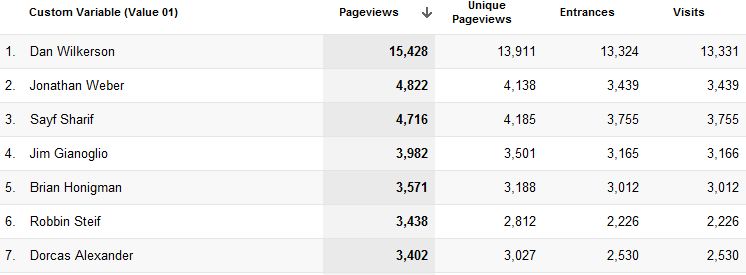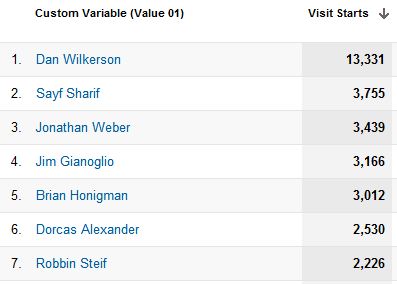Why You Need A Custom Report For Page‑Level Custom Variables
If you have Google Analytics page-level custom variables, you might be missing some data. Click and save our custom report to find out!
What’s this about missing data? It’s more accurate to say it’s hidden, and you might miss it. If you’ve implemented page-level custom variables, you might actually be getting a lot more hits on those pages than the standard reports show.
That’s because the metrics in the standard Custom Variable reports are visit-based, not page-based. But pages don’t get visits, they get pageviews. If you hear someone talking about GA visits for a page, remember: “That word doesn’t mean what you think it means.”
In fact, Google Analytics has tried to clarify this issue by renaming the metrics in the standard Custom Variable reports. Instead of “Visits” they now show “Visit Starts” and “Pages / Visit Start” and so forth.
Visit Starts: The number of visits starting with this value of the custom variable.
For session-level or visitor-level custom variables, the last value of the custom variable applies for the entire visit. Not so for page-level custom variables. Assuming you’ve implemented custom variables correctly, their values apply only to the page on which they are set.
If no visits started with the page where the custom variable was set to value X, then value X will not appear in the standard reports.
That’s right, it will look as if you never tracked any page with that value of the custom variable. It might make you wonder, “Did I get the code wrong?” Or, “Did no one see that page?” Or you may chalk it up to another unsolved Google Analytics mystery.
Well, wonder no more. Take a look at this example of our custom report in action. We’re setting a page-level custom variable with the authors of all our blog posts.
Not only do I get data for authors who had no visit starts in the standard reports (this turns out to be a very small number of authors from several years ago not shown here), I get extra data for all our authors. More like the data I was expecting to get from page-level custom variables in the first place!
Compare the custom report above with the standard report below. You can see that when you try to get GA to give you “visits” for a “page”, what you really get is “visit starts” (aka “entrances”).
Notice something interesting going on here: the order of authors has changed! If I relied on the standard report to tell me the top two authors, I’d get it wrong. Of course Dan is #1 due to his authorship of our weekly Luna TVepisodes and his insanely popular social media sizing cheat sheet. But Jonathan is actually #2. Even though Sayf’s blog posts had more “visit starts”, Jonathan’s had more pageviews.
Simply explained, Jonathan is not currently writing new blog posts, but we link to his old posts all the time. This is also reflected in the fact that certain authors have a higher ratio of unique pageviews to visits (remember, that’s really visit starts). Help Sayf catch up to Jonathan: read his 20 Ways to Use Google Analytics Custom Variables.
Try our custom report for your page-level custom variables. You’ll need to edit the dimension if the CV you want is not in slot #1.
What challenges have you faced with page-level custom variables and how have you addressed them? If you tried our custom report, did you discover anything surprising? Please share in the comments.




